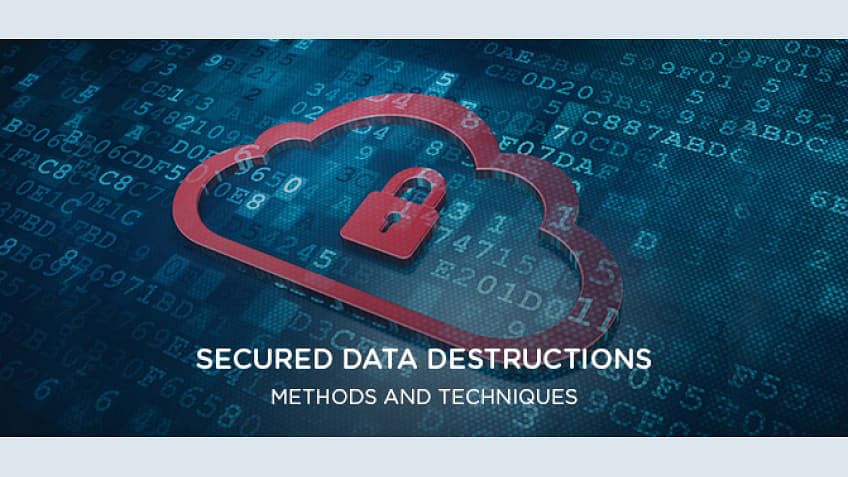Data Destruction Solutions: A Crucial Element in Your Cyber Security Technique
Data Destruction Solutions: A Crucial Element in Your Cyber Security Technique
Blog Article
Discovering the Relevance of Data Devastation in the Context of Computer System Safety Solutions and Protecting Confidential Data
In an age where information breaches are progressively typical, the significance of effective data destruction can not be overstated. Organizations must embrace stringent measures to ensure that delicate info is not only shielded throughout its lifecycle yet additionally decisively removed when no more necessary. The methods employed for data eradication, coupled with compliance to legal requirements, play a pivotal duty in keeping discretion and depend on. Nevertheless, the ramifications of these techniques extend past simple compliance, affecting a company's track record and operational integrity in the electronic industry. What techniques can organizations apply to improve their data devastation methods?
Recognizing Information Devastation
Data devastation is an important part of computer safety that entails the irreversible removal of data from storage gadgets to protect against unauthorized gain access to and possible data violations. In a significantly digital landscape, companies deal with heightened dangers associated with sensitive information being improperly accessed or exploited. Effective data damage safeguards versus these dangers, guaranteeing that personal dataâEUR" such as customer info, intellectual residential property, and monetary recordsâEUR" can not be recuperated after disposal.
Understanding the relevance of data devastation expands past mere compliance with regulatory and lawful structures; it is important for preserving business stability and trust fund. When information is poorly managed or inadequately ruined, the repercussions can be serious, including economic loss, reputational damage, and legal obligations.

Methods of Data Obliteration

One common technique is data wiping, which involves overwriting existing information with random patterns multiple times. This technique makes the original information irretrievable, making it a prominent choice for companies looking for to secure personal details.
Another method is degaussing, which uses an effective magnetic field to disrupt the magnetic domains on storage devices, successfully eliminating the information. This technique is especially effective for magnetic media but is not applicable to solid-state drives.
Physical destruction is another durable approach, squashing or entailing the shredding of storage tools. This approach guarantees that data recovery is basically impossible, making it perfect for extremely sensitive info.
Lastly, encryption can work as a complementary strategy to information eradication. By securing information prior to removal, organizations can include an added layer of safety, making certain that even if residues are recouped, they remain inaccessible without the decryption trick. Each approach ought to be picked based on the degree of information level of sensitivity and the specific safety demands of the organization.
Legal Compliance and Information Safety And Security
Organizations have to navigate a complicated landscape of lawful requirements associated with information safety and security, especially after executing techniques of information eradication. Various guidelines, such as the General Data Defense Law (GDPR) and the Health And Wellness Insurance Policy Portability and Accountability Act (HIPAA), impose rigorous standards on how organizations should get rid of and handle of delicate data. Failure to abide with these policies can bring about substantial legal consequences, consisting of significant fines and reputational damage.
Data destruction procedures should be diligently documented to show conformity with applicable regulations and standards. This documentation not just acts as proof of adherence to lawful obligations yet additionally illustrates a commitment to protecting sensitive information. Organizations should also develop clear plans relating to information retention and damage timelines, making certain that data is not held longer than needed.

Additionally, regular audits and analyses of information devastation techniques are important to keep conformity and adjust to evolving lawful frameworks (data destruction). By proactively resolving legal demands, organizations can minimize risks linked with information breaches and show their commitment to data protection. Ultimately, prioritizing legal compliance in data devastation procedures is this website not simply a regulative obligation, yet an essential facet of a durable information protection approach
Effect On Business Online Reputation
The online reputation of a service can be substantially influenced by its approach to data devastation and monitoring. In today's electronic landscape, where data violations can occur anytime, the failure to effectively take care of sensitive info can result in severe effects. Organizations that improperly take care of information damage threat subjecting private customer information, which not only breaches privacy laws yet likewise erodes count on among clients and stakeholders.
A damaged track record can lead to reduced consumer commitment, as clients end up being reluctant to engage with a business that has shown negligence in shielding their data. Adverse attention bordering an information breach can have a long-term impact, as possible customers might be deterred by the viewed absence of protection. This can cause a direct decline in profits and market share.
Additionally, businesses that focus on information damage as part of their protection technique can enhance their credibility by showcasing their commitment to guarding delicate details. By taking on rigid information administration practices, companies can not just minimize threats however additionally place themselves as reliable entities in their corresponding sectors, thus enhancing their overall brand image.

Best Practices for Secure Disposal
Executing finest methods for secure disposal of data is crucial for alleviating threats related to data violations and ensuring conformity with privacy policies. Organizations must take on a detailed data disposal policy that details procedures for both physical and digital information devastation.
For physical data storage space devices, such as hard disk drives, shredding or degaussing is suggested to avoid data recovery. Furthermore, organizations must maintain a chain of wardship documents during the disposal process, making sure accountability and traceability of disposed things.
For electronic data, utilizing software application that adheres to sector requirements for information cleaning is crucial. This software program click to read more needs to overwrite existing information numerous times, making recuperation practically impossible. It is likewise vital to verify the efficiency of the information devastation process through audits or third-party analyses.
Training staff members on safe disposal methods adds another layer of safety and security, as human mistake can frequently cause data exposure. Regularly evaluating and upgrading disposal policies makes sure positioning with advancing laws and technological innovations. By carrying out these ideal practices, companies can Full Report dramatically minimize the risk of unapproved information accessibility and improve their total information security strategy.
Conclusion
To conclude, information damage is an essential element of computer security solutions that guarantees the security of secret information from unapproved access. Executing reliable methods of data elimination, sticking to lawful conformity, and acknowledging the influence on company credibility are essential elements of an extensive data safety approach. By embracing best techniques for safe disposal, companies can foster trust with customers and safeguard delicate data, ultimately adding to a more secure electronic landscape.
In a period where data breaches are progressively typical, the relevance of reliable data damage can not be overstated.Data devastation is an important part of computer security that entails the permanent elimination of data from storage space gadgets to protect against unapproved gain access to and potential data violations. Organizations needs to additionally establish clear plans regarding information retention and devastation timelines, guaranteeing that data is not held longer than necessary.
By proactively dealing with lawful needs, organizations can minimize dangers associated with data violations and show their commitment to information security (data destruction). Eventually, focusing on lawful compliance in data damage procedures is not simply a regulative responsibility, however a basic aspect of a durable information safety technique
Report this page